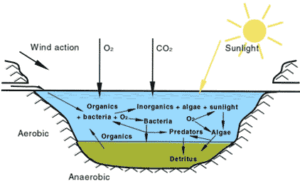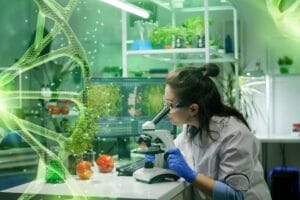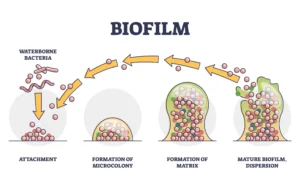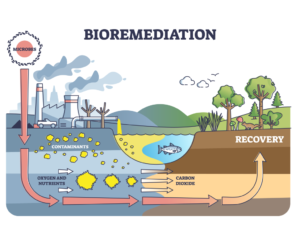Lagoons in Wastewater Treatment
Lagoons are shallow, engineered basins used for treating wastewater through natural processes involving biological, physical, and chemical mechanisms. These systems rely on the interaction of microorganisms, algae, sunlight, and wind to degrade organic matter, remove pathogens, and improve water quality. Lagoons are cost-effective, energy-efficient, and easy to operate, making them suitable for small- to medium-sized communities and industries with sufficient land availability.
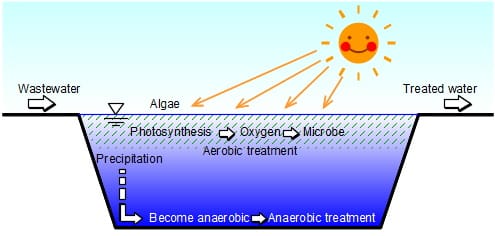
Types of Lagoons
Lagoons are classified based on their oxygen requirements and treatment processes:
1. Anaerobic Lagoons
Description
Anaerobic lagoons are deep basins designed to operate in the absence of oxygen. They are typically used for treating high-strength wastewater with high organic and solid content, such as from agricultural operations (e.g., livestock farms), food processing industries, or municipal sewage.
Design Features
- Depth: 3–6 meters to restrict oxygen penetration.
- Retention Time: Long hydraulic retention times (20–50 days) to allow complete digestion.
- Lining: Often lined to prevent groundwater contamination.
Mechanism
- Organic matter undergoes anaerobic digestion in three stages:
- Hydrolysis: Complex organic materials (carbohydrates, proteins, and fats) are broken into simpler compounds.
- Acidogenesis: These simpler compounds are fermented to produce volatile fatty acids (VFAs) and gases like hydrogen (H₂) and carbon dioxide (CO₂).
- Methanogenesis: Methane-producing microorganisms convert VFAs into methane (CH₄) and CO₂.
- Sludge settles at the bottom and decomposes further over time.
Applications
- Treating high-strength industrial wastewater (e.g., meatpacking, dairy, breweries).
- Managing animal waste from farms (manure treatment).
Advantages
- High BOD (Biochemical Oxygen Demand) and organic load removal.
- Biogas production as a renewable energy source.
- Low operational costs and minimal energy requirements.
Disadvantages
- Odor issues due to the release of hydrogen sulfide and other gases.
- Risk of groundwater contamination without proper lining.
- Requires a large land area and long retention times.
2. Facultative Lagoons
Description
Facultative lagoons are the most common type of lagoon used for wastewater treatment. These lagoons operate under both aerobic and anaerobic conditions, with the top layer exposed to oxygen and the bottom layer remaining oxygen-deprived.
Design Features
- Depth: 1.2–2.4 meters, shallow enough to allow oxygen diffusion but deep enough to develop anaerobic zones.
- Retention Time: 5–30 days, depending on wastewater characteristics.
- Zones:
- Aerobic Zone (Surface): Oxygen is supplied by atmospheric diffusion and algal photosynthesis.
- Facultative Zone (Middle): Microorganisms adapt to low oxygen or anaerobic conditions.
- Anaerobic Zone (Bottom): Organic solids settle and undergo anaerobic digestion.
Mechanism
- Surface algae produce oxygen through photosynthesis, which supports aerobic bacteria in breaking down organic matter.
- Deeper layers rely on anaerobic bacteria for organic degradation.
- Facultative bacteria in the middle zone switch between aerobic and anaerobic metabolism depending on oxygen availability.
Applications
- Treating municipal wastewater.
- Industrial wastewater with moderate organic loads.
Advantages
- Can handle fluctuating organic loads.
- Minimal mechanical equipment is needed.
- Low maintenance and operational costs.
Disadvantages
- Requires a large land area.
- Potential odor issues during anaerobic activity.
- Risk of seasonal performance variations due to temperature and sunlight.
3. Aerobic Lagoons
Description
Aerobic lagoons are shallow basins designed to maintain aerobic conditions throughout their depth. They rely on atmospheric oxygen and photosynthetic oxygen production by algae for microbial degradation of organic matter.
Design Features
- Depth: 0.3–0.6 meters, ensuring oxygen penetration throughout the lagoon.
- Retention Time: 3–10 days for effective treatment.
- Often used as a secondary or polishing step after other treatment processes.
Mechanism
- Algae perform photosynthesis, releasing oxygen into the water.
- Aerobic bacteria use this oxygen to degrade organic matter.
- Organic pollutants are converted into carbon dioxide and biomass.
Applications
- Low-strength wastewater treatment.
- Polishing treatment to improve effluent quality.
Advantages
- Minimal odor generation.
- Simple operation with no mechanical aeration required.
- Effective pathogen reduction due to high oxygen levels and sunlight exposure.
Disadvantages
- Limited to low-strength wastewater.
- Algal growth may require periodic removal.
- Sensitive to seasonal changes in light and temperature.
4. Maturation (Polishing) Lagoons
Description
Maturation lagoons are typically the final stage in a lagoon treatment system, focusing on improving effluent quality by removing remaining pathogens, nutrients, and suspended solids.
Design Features
- Depth: 0.5–1.5 meters to allow sunlight penetration.
- Retention Time: 3–20 days, depending on effluent quality requirements.
- It may include multiple cells for stepwise treatment.
Mechanism
- Sunlight exposure reduces pathogens by increasing UV radiation levels.
- Nutrient removal occurs through algal uptake and microbial activity.
- Sedimentation reduces suspended solids.
Applications
- Final treatment step for municipal and industrial wastewater.
- Effluent polishing to meet discharge standards.
Advantages
- Effective pathogen reduction.
- Enhances effluent clarity and quality.
- Simple and passive treatment process.
Disadvantages
- Requires a large land area.
- Dependent on sunlight and temperature.
- It may require additional disinfection for complete pathogen removal.
Factors Affecting Lagoon Performance
- Temperature: Higher temperatures enhance microbial activity and pathogen reduction.
- Retention Time: Sufficient time is needed for organic matter degradation and pathogen die-off.
- pH: Optimal pH ranges from 6.5 to 9 for microbial activity.
- Sunlight: Essential for algal photosynthesis and pathogen inactivation.
- Wind: Promotes surface aeration and mixing.
Comparison of Lagoon Types
| Lagoon Type | Depth (m) | Oxygen Conditions | Main Applications | Key Benefits | Drawbacks |
|---|---|---|---|---|---|
| Anaerobic | 3–6 | Anaerobic | High-strength wastewater | Biogas recovery | Odor, slow process |
| Facultative | 1.2–2.4 | Aerobic (top) & Anaerobic (bottom) | Municipal/industrial wastewater | Handles variable loads | Large area needed |
| Aerobic | 0.3–0.6 | Aerobic | Low-strength wastewater/polishing | Odor-free, easy to maintain | Limited organic capacity |
| Maturation/Polishing | 0.5–1.5 | Aerobic | Final effluent polishing | Pathogen reduction | Land-intensive |
Lagoons are versatile and efficient for wastewater treatment, particularly in areas with sufficient land availability. The choice of lagoon type depends on the wastewater characteristics, treatment goals, and environmental conditions. Proper design and maintenance are


